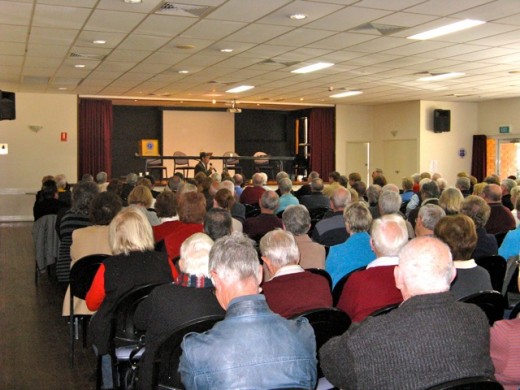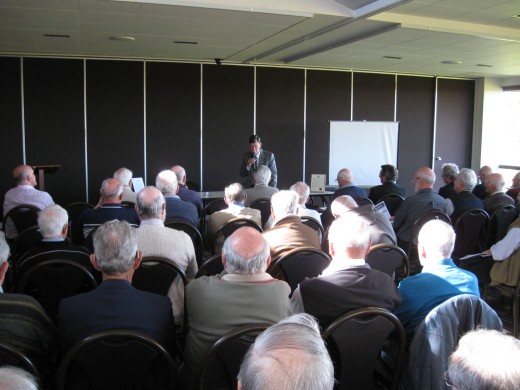Speaking Tips - Facing Your Listener plus Eye Contact

Speaking Tips – Facing Your Listener plus Eye Contact
On looking at the title of this particular Hub you might be tempted to think, “Of course, I know I’m to face my audience when I speak,” and you would, of course, be right. And, “I know I should give them eye contact.” In this Hub we will delve into that aspect of speaking just a little bit deeper. We hear a lot about eye-contact and looking at our audience, but we’re often not given the finer detail which makes such contact really effective.
Let us suppose we have an audience of fifty or a hundred people seated theatre style in front of us. How are we going to establish rapport with them by the use of eye-contact? It would be impossible to do all of them justice in the time allotted for our presentation. So what should we do?
Acceptance by our listeners - the first requirement
Before we even consider eye-contact, something else needs to be looked at: acceptance by our listeners. In a one-on-one meeting in a social scenario we walk up to – or are approached by – another human being who faces us full on. Our eyes meet, and then a customary greeting is made. It could be as simple has “Hi, my name’s, John. Nice to meet you,” and a hand is held out for a handshake. This, in our Western Society, is a cultural norm. We expect it. The person doing the approaching is in this case the Initiator, and that person who is approached is the Reactor. An immediate evaluation is made by the Reactor. He or she either responds positively or negatively. There is mental acceptance or rejection. Even if your hand is shaken in response, if you don’t adequately face them and meet their gaze, the chances are they will not accept you.
Do not be tempted to shift your gaze quickly from one face to another

They want you to acknowledge them
Be that as it may, the niceties of a full frontal stance towards those meeting, and eye contact, is essential before those initial actions of handshakes – or whatever cultural greeting is appropriate – are made. The initial contact should always be: a full frontal stance so that you can be sized up, and eye contact, so there can be a brief, if not conclusive, ‘meeting of souls.’
So, the essence is: full frontal stance, one person facing of the other. If we turn sideways it could be interpreted as a rebuff or some sort of fear. Acceptance would not have been achieved.
In addressing to an audience, a speaker needs to remember this business of full frontal stance and adequate eye-contact. This is what every single one of those listeners in that audience wants. They want you to acknowledge them; accept them, before they are entirely willing to accept you up to that point.
This does not preclude an intimate talk to that person in the front row.

Face all the audience at one time or another
So how do you go about getting acceptance when you’re not able to shake hands with everyone of those people in the audience? Firstly, you give all of them – to the best of your ability – a full frontal stance. You do this by shifting your position so that you’re facing all of the audience at some time or another. No twisting the head around to look. You turn your whole body, meet the gaze of one particular person in one quadrant of the room and talk to him or her.
Just as in a normal one-on-one conversation, your gaze should only be as long as it would be in a normal social situation. No staring, yet no quick flitting of the eye so that no real contact is made. Be normal.
Pick out three people: left hand, right hand, and the central triangle
How can one ensure that every person in that audience feels that you are giving them this all- important full frontal look? That you’re giving them reasonable eye-contact to the point that they will forget about your actions and simply listen to your speech? Obviously you cannot look at all of them. However, you can turn your body so that everyone in, say, the left hand side of the room, gets to see a frontal view of you. The eye contact should go to one person only in that area of the room. However, the audience members in front, behind, and to the sides of the person you are actually looking at also get the impression you are looking at them. Same with the right hand side. Same with the central body of the audience.
The Dinner Function. Same applies. Centre, Left and Right. But don't be pedantic about it

Practice this until it becomes natural and spontaneous
If you can imagine that the audience is divided up so that you have, a triangle of people with you at the lectern as the centre of the base of that triangle, making up the central body of the audience. The two other side lines of this triangle terminating at the centre of the back wall. Here you have your Central Group. That is your ‘audience in the centre.’
A second triangle made up of those lines which have a base at the left side of the back wall, full length of the left-hand wall, and a line going from the bottom left of the stage, to the centre of the back wall. Here you have your Left Hand Group. That is, your ‘audience to the left.’
The Right Hand Group are those whose base lines are the right side of the back wall to the far corner, the entire right-hand wall, and a line going from the right hand side of the stage to the centre of the back wall.
There are three triangles in all.
Sound complicated? It isn't really.
If you can picture these three triangles making up your audience, and can place just one face – preferably a friendly and interested face – in the centre of each of these three triangles, you have your base for being able to present a full-frontal stance, plus adequate eye contact to the whole audience. This is the minimum pre-requisite for optimum audience acceptance.
Sound complicated?
It isn’t really. The point to bear in mind is that everyone in the audience should feel that he or she is personally included in what is, after all, simply a one-on-one conversation between you and him or her. The fact that there are many others in the audience should not detract from that intimacy of a ‘one-on-one.’ “He’s speaking to me – to me, personally,” should be the automatic, subconscious reaction of each and every listener.
Theatre style seating in a room adequately filled is ideal

You need to have the entire audience believing you're speaking to them personally
So, when you turn your whole body and look at that man or woman in the left triangle of that auditorium, every one of those in that area of the room will assume you’re turning towards and making eye-contact with them. Same goes for the other two triangular areas. By giving your full attention, just as you would in a one-on-one conversation, to just these three people, you can have the entire audience believing you were speaking to them personally. Bu doing this, you will set you apart as being a speaker who really does communicate. And isn’t this what it’s all about?...
More on the writer
- Tom Ware Public Speaking The Prince of Storytellers
Tom Ware Public Speaking! Tips, events and videos to help you become a gifted speaker. Visit now!







